How to Build a Website Like Alibaba: Features, Costs and Monetization Strategies
Want to build a multi-vendor marketplace similar to Alibaba? You’re at the right place. This comprehensive craft will help you explore everything about Alibaba, from its introduction and business model to subsidiaries, revenue model, key features, steps to build, investment needed, and the right solution you can choose.
However, before we dive deep, let’s explore why build an eCommerce platform similar to Alibaba?
According to Statista, Alibaba Group recorded revenue of approximately $137.3 billion (996.35 billion yuan) in the fiscal year ending March 31, 2025. You can see a continuous growth in Alibaba’s revenue from 2015 to 2025.
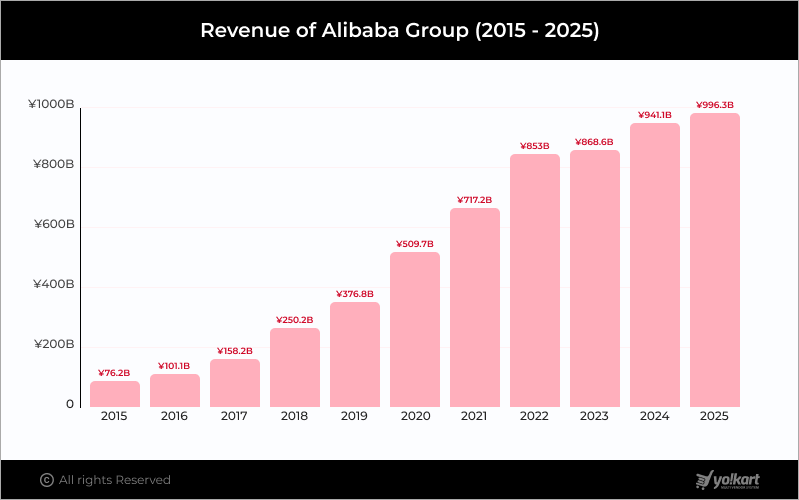
What attracts entrepreneurs more to build a marketplace like Alibaba is its diversified revenue channels and business models. It generates revenue through multiple sources and drives consistent growth via its strategic business model.
Moreover, by building a marketplace like Alibaba, you will not just create a centralized digital platform to connect buyers and sellers, but can extend your business beyond. Let’s explore how to create a website like Alibaba.
Table of Contents
- What is Alibaba?
- Alibaba History: Key Milestones and Achievements
- Business Model: How Does Alibaba Work?
- Top Well-Recognized Subsidiaries/Businesses of Alibaba Group
- Alibaba Revenue Model: How Does Alibaba Make Money?
- Revenue Distribution of Alibaba by Segment
- Key Features of Alibaba B2B Multi-Vendor eCommerce Platform
- How Much Does it Cost to Build an eCommerce Platform Similar to Alibaba?
- How to Build a Website or Marketplace Like Alibaba?
- Build a Multi-Vendor Marketplace Like Alibaba at an Affordable Cost
- Final Thought
- FAQs
What is Alibaba?
Alibaba is a leading B2B multi-vendor marketplace that enables buying and selling products in bulk. The platform is specially designed for B2B trade. It connects businesses (buyers) that prefer good margins with suppliers (vendors) seeking large quantity orders.
There are millions of active buyers, manufacturers, suppliers and wholesalers listed and registered on Alibaba. The marketplace handles approximately 300,000 trades daily. On the one hand, vendors connect with millions of global buyers. On the other hand, buyers also gain access to a wide variety of products from distinct categories and niches.
Alibaba’s offerings are not limited to products; it also extends to services, cloud computing, entertainment, logistics, finance, artificial intelligence, and more.
In short, Alibaba Group is a one-stop destination for individuals and businesses that offers a comprehensive digital solution, from selling products in bulk to selling to individual customers, providing cloud computing services to leveraging AI products, enabling a payment system to offering loans and providing a video streaming platform to making films.
- Parent organization: Alibaba Group
- Founded: April 4, 1999
- Headquarters: Hangzhou, China
- Company Type: Private
- Geographical Presence: Global
Alibaba History: Key Milestones and Achievements
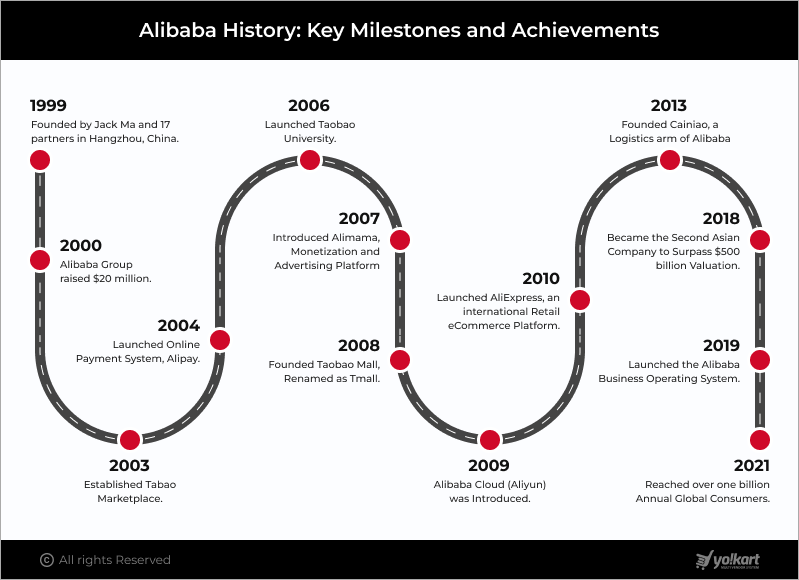
- 1999: Founded by Jack Ma and 17 partners in Hangzhou, China.
Launched China Marketplace (Currently 1688.com) - 2000: Alibaba Group raised $20 million.
- 2003: Established Tabao Marketplace
- 2004: Launched Online Payment System, Alipay.
- 2006: Launched Taobao University
- 2007: Introduced Alimama, Monetization and Advertising Platform
- 2008: Founded Taobao Mall, Renamed as Tmall (2011)
- 2009: Alibaba Cloud (Aliyun) was Introduced.
- 2010: Launched AliExpress, an international Retail eCommerce Platform.
- 2013: Founded Cainiao, a Logistics arm of Alibaba
- 2018: Became the Second Asian Company to Surpass $500 billion Valuation.
- 2019: Launched the Alibaba Business Operating System.
- 2021: Reached over one billion Annual Global Consumers
Business Model: How Does Alibaba Work?
Alibaba is a dedicated B2B multi-vendor marketplace that works as an intermediary between businesses. It connects businesses, including buyers and sellers, to trade in bulk. Manufacturers, distributors and suppliers primarily from China list their products and connect with buyers across the world. Buyers, on the other hand, visit the marketplace and find products at a good value.
Vendors’ Journey on Alibaba
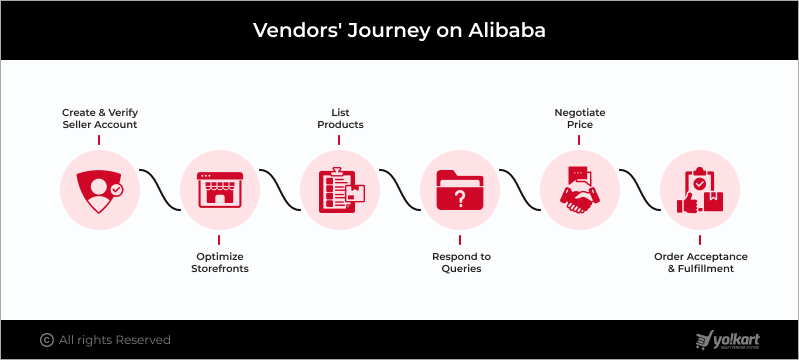
- Create and Verify Seller Account
- Optimize storefronts
- List Products
- Respond to Queries
- Negotiate Price
- Order Acceptance and Fulfillment
Buyers’ Journey on Alibaba
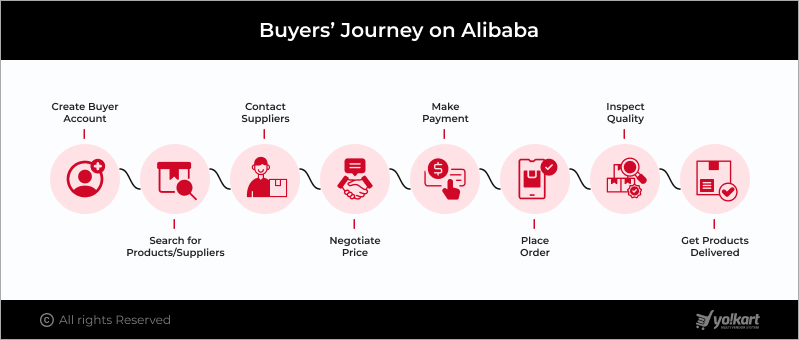
- Create Buyer Account
- Search for Products/Suppliers
- Contact Suppliers
- Negotiate Price
- Make Payment
- Place Order
- Inspect Quality (Through Alibaba Third-party Inspection Services or by Yourself
- Get Products Delivered
Buyers can also take post-delivery actions, such as providing feedback on the product or supplier, or contacting customer support for any complaints, concerns, or queries.
| Admin controls and manages the entire marketplace’s operations, including user management, payment management, order management, role management, return and complaint management, marketing, promotions and much more. |
Top Well-Recognized Subsidiaries/Businesses of Alibaba Group
However, alongside product sales, the Alibaba Group follows a diversified business model that makes it an ideal inspiration for entrepreneurs and business owners who tap into the eCommerce world and extend their offerings beyond. Let’s explore some widely recognized subsidiaries or businesses operated by Alibaba Group that contribute to its growth and expansion.
| Subsidiary | Founded Year | Key Offerings |
| 1688.com | April 1999 | A Chinese B2B eCommerce platform focused on the domestic market. |
| Taobao | May 2003 | A consumer-to-consumer (C2C) marketplace popular across China. |
| AliPay | February 2004 | A widely used digital payment service in China. |
| Youku | December 2006 | A major online video platform, often compared to YouTube. |
| Alimama | November 2007 | A digital marketing and monetization platform by Alibaba Group. |
| Tmall | April 2008 | A B2C platform featuring high-quality products from top brands. |
| Aliyun (Alibaba Cloud) | September 2009 | Global cloud computing solutions provider. |
| AliExpress | April 2010 | A global B2C eCommerce platform connecting buyers with Chinese suppliers. |
| Lazada | May 2012 | A leading Southeast Asian eCommerce marketplace. |
| Cainiao | May 2013 | A smart logistics network enabling fast domestic and cross-border deliveries. |
| DingTalk | December 2014 | An enterprise communication and collaboration platform. |
Want to Build an eCommerce Website Similar to Alibaba or its Subsidiaries?
Alibaba Revenue Model: How Does Alibaba Make Money?
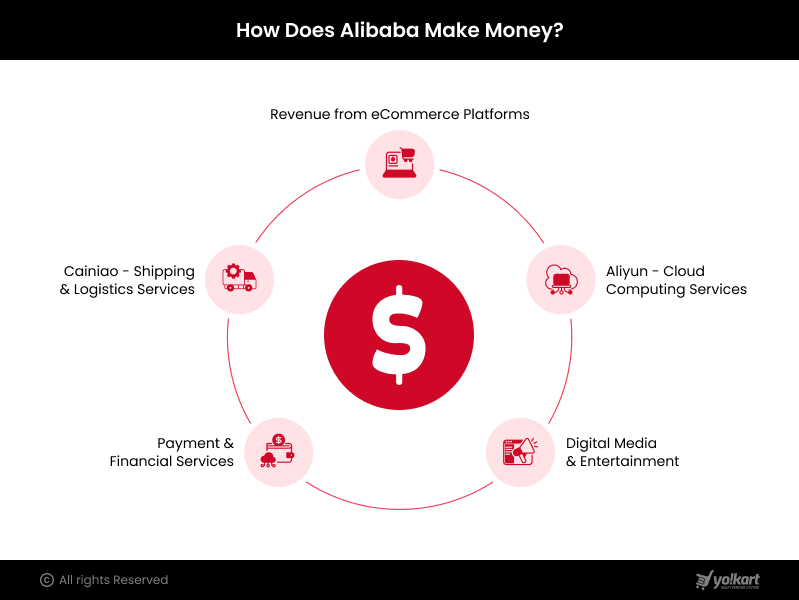
Whether you are a buyer or a seller, user registration and product listing on Alibaba are free. However, its diversified revenue models ensure steady income for the business.
The platform primarily generates revenue through advertising, membership fees, and commission on transactions. While some platforms like Tmall and AliExpress charge commissions on sales, others like Taobao and Alibaba itself rely more on advertising and subscription fees.
In addition, Alibaba Group earns money from its extended services such as cloud computing, logistics, and more. Let’s get an overview of the revenue model of Alibaba below:
Alibaba’s Revenue from eCommerce Platforms
Alibaba and its sister eCommerce platform enable the selling of products in retail and wholesale. These platforms generate revenue from multiple revenue streams. Tmall and Taobao are leading eCommerce platforms that generate a vast amount of revenue for Alibaba. Below are a few revenue streams that contribute to the company’s revenue.
- Commission: Alibaba itself doesn’t charge commission on sales. However, its sister platforms, such as AliExpress, Tmall and Juhuasuan, charge a percentage of GMV (Gross Merchandise Value) on transactions initiated or settled via Alipay.
- Membership and Subscription Fees: Membership and subscription-based services are another revenue generation source for Alibaba. Subscription prices varied by plans and offerings.
Primarily, Alibaba offers two different pricing plans: basic and standard. The subscriber can choose either a quarterly or an annual plan. These membership plans provide access to premium services and features, offering subscribers several exclusive benefits. Alibaba’s premium membership program 88VIP has continued to gain traction among its members.
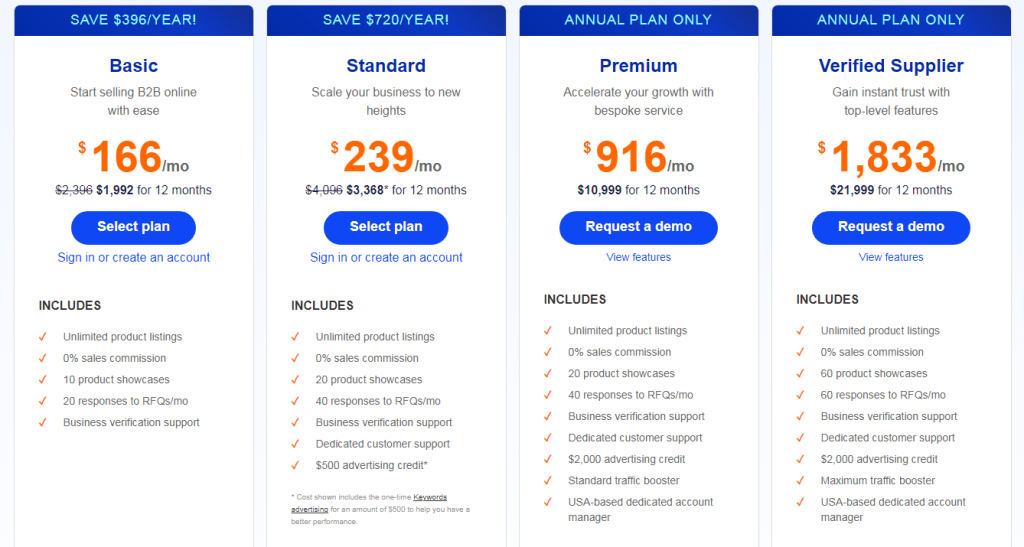
- Advertisements and Sponsored Ads: A significant percentage of Alibaba’s revenue comes from marketing services (advertising and sponsored ads). Merchants and third-party advertisers pay Alibaba in order to promote products, increase visibility, display banner ads, rank keywords and more.
Alimama is the advertising platform that analyses data across platforms and enables targeted marketing across the Alibaba ecosystem.
Suggested Read: How Does Alibaba Make Money : A Detailed Guide
Alibaba’s Revenue from Aliyun (Cloud Computing Services)
Aliyun, Alibaba’s cloud computing arm, has reported year-on-year revenue growth. It provides services like computing, storage, data management and AI solutions. It enables businesses to choose subscription plans or incur charges based on services used, pay-as-you-go.
AI-related products remain key growth drivers for Alibaba Cloud. In the first year of 2025, Alibaba Cloud reported revenue of $16.26 billion. Moreover, by analyzing the rapid adoption of AI products, Alibaba has planned to invest in cloud and AI infrastructure to sustain its growth and expansion.
Alibaba’s Revenue from Cainiao (Shipping and Logistics Services)
Cainiao is one of the world’s largest cross-border eCommerce logistics services providers. It’s one of Alibaba’s leading revenue sources. At the same time, Cainiao is also one of the fastest-growing units.
Cainiao generates revenue from services including warehousing, transportation, pick-up services, last-mile delivery and more. The highlight is that Cainiao generates a significant portion, about 70% from external sources and the remaining 30% of revenue comes from serving Alibaba’s internal needs.
Alibaba’s Revenue from Payment and Financial Services
Alibaba generates revenue from Alipay and other financial services. However, Alipay is now part of Alibaba’s financial services known as Ant Financial. It offers a range of payment and financial services. These services include payment processing, micro-loans, digital banking, wealth management and more. Moreover, Ant Group generates revenue via a combination of fees, interests, and transactional charges.
- Transaction Fees (Alipay): Alipay incurs transactional charges on transactions that take place through the platform. Moreover, utility payments, credit card services, insurance and other services also contribute to Alipay’s revenue.
- Loan Interest: The company also offers loans to customers and earns interest on them.
- Revenue from other Services: In addition to the above-mentioned revenue channels, Ant Financial charges fees and commissions to offer services like wealth management, digital payment and others.
Alibaba’s Revenue from Digital Media and Entertainment
Alibaba Digital Media and Entertainment is another source that generates revenue through subscription fees, licensing, and advertising. This segment of Alibaba includes Youku, a video streaming platform; Alibaba Music, a music division focusing on copyrights and more related to the industry; Alibaba Pictures produces films and TV shows; AliSports, UC web and more.
They all drive revenue for Alibaba in several ways. Such as Youku generates revenue through subscriptions and advertisements and Alibaba Pictures generates revenue by producing films and TV shows.
Revenue Distribution of Alibaba by Segment
The table below defines the revenue share of the Chinese eCommerce conglomerate Alibaba Group by segment. You can see the percentages of Alibaba’s revenue in the second quarter of 2025.
| Alibaba’s Segment/Subsidiary/Business | Revenue Percentage |
| China Commerce Retail | 47.88% |
| All others | 23.66% |
| Cloud Intelligence Group | 13.49% |
| International Commerce Retail | 11.47% |
| Quick Commerce | 5.7% |
| International Commerce Wholesale | 2.56% |
| China Commerce Wholesale | 2.46% |
Key Features of Alibaba B2B Multi-Vendor eCommerce Platform
Operating an online multi-vendor marketplace requires the necessary features and functionality to ensure a seamless and hassle-free experience for users. Similarly, being a leading B2B multi-vendor marketplace, Alibaba offers advanced out-of-the-box features and functionality.
It enables users to navigate complete transactions effortlessly. On Alibaba, two different users primarily participate: buyers and sellers. Let’s explore user-wise key features of Alibaba below:
Features for Buyers
Buyer is the first; at the same time, it’s the end user on the marketplace. The role of a buyer begins with a product search to end with leaving a review and ratings. Below are buyer-specific features of Alibaba:
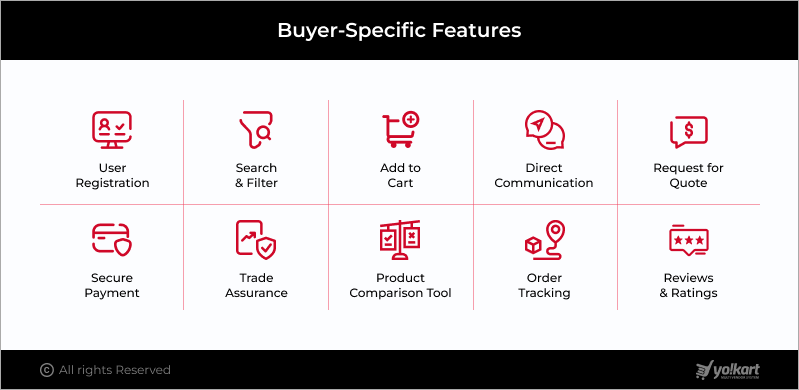
- Easy Registration and Login: Alibaba enables easy registration for buyers. They can register in just a few steps.
- Create an account by providing details like name, email address, location, and phone number.
- Complete security verification by verifying phone and email, entering the verification code.
- Add and verify payment details.
- Search and Filter: Buyers can find the results they are looking for. They search and view results by product, supplier, or worldwide. Buyers can also short products by enabling a toggle ‘Show manufacturers only’.
In addition, buyers on Alibaba can filter products at multiple levels to get more precise and relevant search results. These filters may include supplier country/region, supplier features, store reviews, certification and more. However, the filters can vary depending on the product category and types.

Alibaba also enables product search using images. Buyers can upload, paste or drag and drop images to search. They can even take snaps using Alibaba Lens to find results.

- Add to Cart: Buyers can collect and save items to the cart they want to buy or view later. The add to cart option also helps buyers to streamline the ordering process by enabling buyers to check out multiple products altogether.
- Chat/Contact Seller: Alibaba provides direct messaging tools with real-time translation to negotiate deals, share customized order requirements, and discuss terms such as pricing, quantity, and shipping. These options may include direct charting and contacting the supplier.

- Request for Quote (RFQ): Using this feature, buyers send and receive RFQ (Request for Quote). They can either raise a request to a particular seller or raise a universal request in order to grab the best possible deal, and any of the sellers can counteroffer.
- Secure Payment: Alibaba offers multiple and secure payment options for buyers. Each payment made on Alibaba is secured with strict SSL encryption and PCI DSS data protection protocols. Moreover, buyers can make payments using their preferred methods.
- Trade Assurance: Works as a protective shield for buyers on Alibaba. It safeguards payments, ensures on-time shipment and guarantees buyers receive the product delivered with optimal quality.
- Product Comparison Tools: Alibaba offers a feature that lets buyers compare products and suppliers simultaneously based on features, performance, and popularity. Buyers can compare up to 20 products or suppliers and choose.
- Order Tracking: One of the important features for buyers on any platform. Order tracking allows buyers to track orders and get updates on their current statuses. Alibaba allows its buyers to track orders using the built-in order tracking system.
- Reviews and Ratings: Buyers on Alibaba can post a review and rate using this feature. However, reviews and ratings on Alibaba are of different types that include:
- Verified purchase reviews: Buyers post reviews 90 days after the transaction is completed.
- Unverified purchase reviews: Buyers may leave reviews without a fully completed transaction on the platform.
- High-level buyers: High-level buyers who have had multiple interactions with a seller may post reviews on the seller’s service within 180 days after such an incident.
Looking for a Feature-rich Multi-Vendor Marketplace Solution?
Features for Suppliers
Vendors on Alibaba are manufacturers, suppliers and wholesalers who list and sell products on the platform. Alibaba brings all the necessary features for vendors. Enabling them to create unique storefronts to process and deliver orders, they perform all the tasks seamlessly. Let’s explore vendor-specific features of Alibaba below:
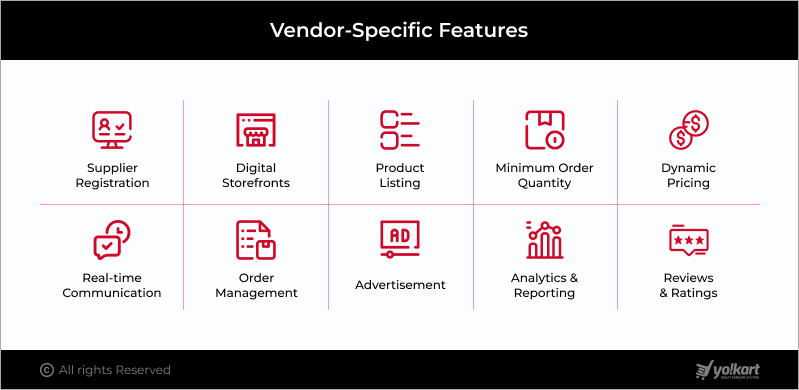
- Supplier Registration: Whether you are a manufacturer, wholesaler or supplier, Alibaba makes onboarding easy. You can register your business on Alibaba by simply providing and verifying the necessary details related to your business. Once registered, you can get started.
- Digital Storefronts: Alibaba provides an option for vendors to set up their own digital storefronts on the marketplace. They can customize and set up their online store, inclusively showcasing their products and businesses.

- Product Listing: Suppliers on Alibaba can either list products in bulk using the import export option or can list a single product, providing all the necessary details.
- Minimum Order Quantity: Using this feature, suppliers can restrict buyers from placing orders less than the quantity set. As Alibaba is a B2B focused marketplace, MOQ encourages bulk ordering and lets the suppliers handle order fulfillment, operations and efficiency.
- Dynamic Pricing: Alibaba enables vendors to make maximum profit using the dynamic pricing feature. This feature automatically adjusts pricing by analyzing various factors such as demand, competition and other market conditions.
- Direct and Real-time Communication: Each sales journey begins with a query. Alibaba’s direct and easy communication channels enable suppliers to directly interact with buyers on their queries in 18 languages, offering real-time translations.
In order to enable real-time communication, Alibaba also provides the AliSupplier app that allows suppliers to respond to buyers immediately, contributing to higher conversion chances.
- Order Management: Order management features on Alibaba allow suppliers to complete the ordering process. Starting from accepting orders to updating their statuses and communicating with buyers to ensure doorstep delivery, they can manage every aspect of the order.
- Advertisement: Alibaba allows suppliers to increase visibility of their products via paid ad campaigns. They can precisely target potential buyers through keywords, increase visibility in search results and boost conversion rates.
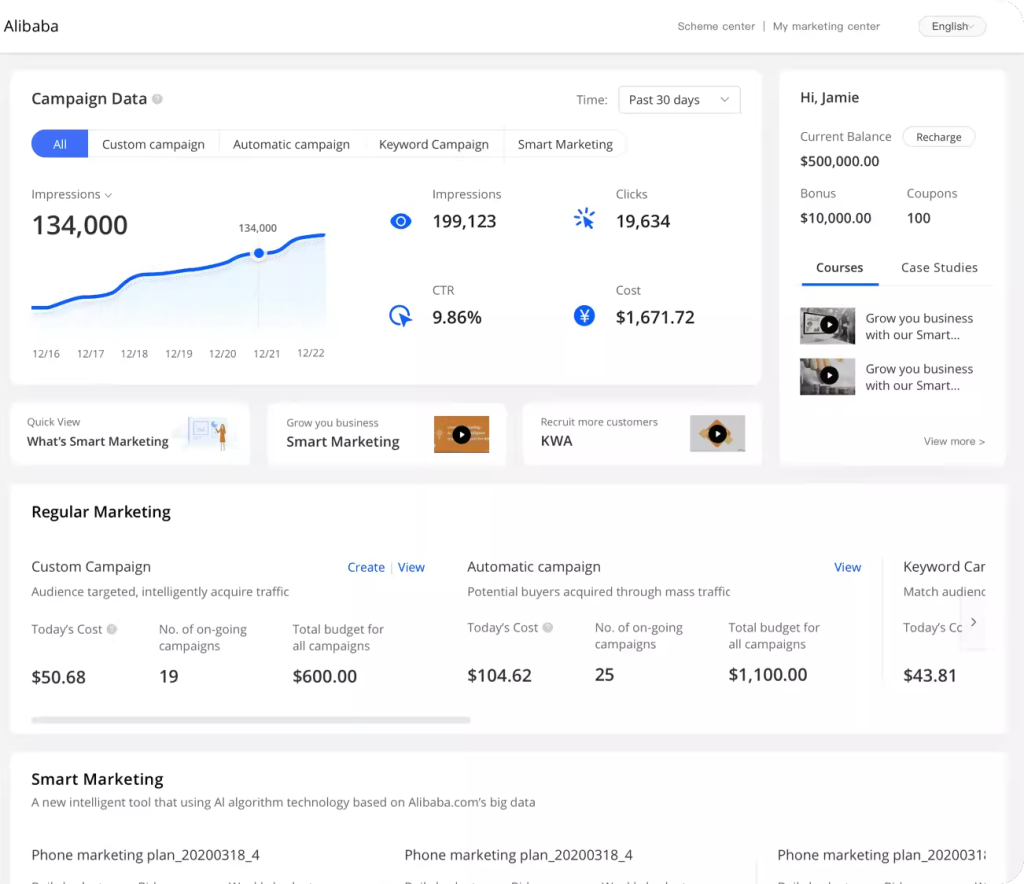
- Analytics and Reporting: Accessing the analytics and reporting dashboard, the supplier can get a complete overview of valuable data and insights, including order details, users’ behavior, search queries, conversion rates, the number of visitors and more. By analyzing these reports, suppliers can plan further strategies and implement them to drive more sales.

Features for Admin
Admin is the marketplace operator that operates, manages and grows the platform. From managing users to ensuring seamless operations, analyzing reports to processing payments, promoting business to acquiring users, implementing emerging technologies to taking care of updates, the admin requires all the necessary features to handle these operations.
Similarly, a B2B multi-vendor marketplace like Alibaba supports all the admin features that ensure seamless marketplace operations. However, Alibaba’s admin features are not officially available. Yet, you can check out these features required for the B2B marketplace admin:
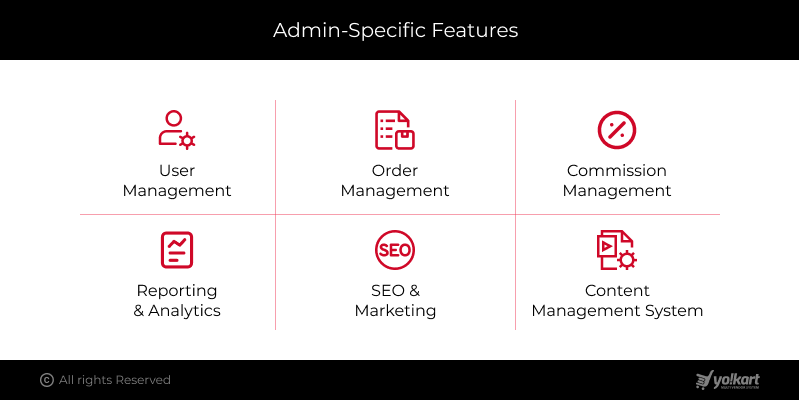
- User management: User management is an option that allows admins to manage the roles of different users including suppliers and buyers. In addition, the admin can also assign a sub-admin role to distribute workloads.
- Revenue/Commission Management: Admins need features to implement and manage multiple revenue streams such as commissions, subscription charges and more.
- Order Management: The order management feature provides complete control over the order-related operations to the admin. They handle everything, including refund and return management.
- Reporting and Analytics: Reporting and analytics in the Admin dashboard provide a complete overview of valuable data and insights of the marketplace.
Whether it’s about the number of users, transactions, tax, commission, or more, the reports showcase everything they need. In addition, by analyzing these data and insights, the admin can plan strategies and grow the marketplace.
- SEO and Marketing: In this highly competitive world, growing businesses require smart strategies, continuous effort and the right tools. SEO and marketing tools enable admins to drive more traffic, engagement and sales organically and through paid campaigns. They plan several marketing
- Content Management System: CMS is another important feature/tool that helps customize the marketplace, enhance user experience and tailor the platform as per the specific requirements without the need for coding expertise. They can easily create, manage, organize, and publish digital content on the marketplace.
How Much Does it Cost to Build an eCommerce Platform Similar to Alibaba?
Deciding on the cost to build a marketplace like Alibaba requires several considerations. The price can vary widely depending on factors such as the approach, technological requirements, features, functionality, integrations and other specific needs or complexity of the marketplace. In short, building a marketplace like Alibaba can cost anywhere between $10,000 – $1,00,000 or more.
However, you can build a B2B marketplace like Alibaba in two popular ways: build from scratch or choose a readymade solution.
Cost to Build an Alibaba-like Marketplace from Scratch
In this approach, you build an Alibaba-like marketplace from the ground up, which requires a significant amount of time, resources and money.
- Cost to Build from Scratch: Anywhere between $50000 – $100000 or more.
- Timeline: 6 to 12 months or more.
Cost to Build a Marketplace like Alibaba Using a Readymade Solution
Choosing a readymade B2B marketplace software can significantly reduce costs and timelines. Suppose you’re building an Alibaba-like eCommerce platform using Yo!Kart B2B, a readymade and dedicated B2B solution. The price can drop unexpectedly from thousands of dollars to a few hundred dollars.
- Cost to Build Using Readymade Solution (Yo!Kart B2B): Starting at $1249 (One-time)
- Timeline: 2 – 4 weeks
| Our Recommendation: Building a B2B marketplace using a readymade solution like Yo!Kart B2B can significantly reduce the cost. What makes it a preferred choice is that it offers a similar level of control and customization flexibility to custom development. |
Build a Marketplace like Alibaba at an Affordable Cost
How to Build a Website or Marketplace Like Alibaba?
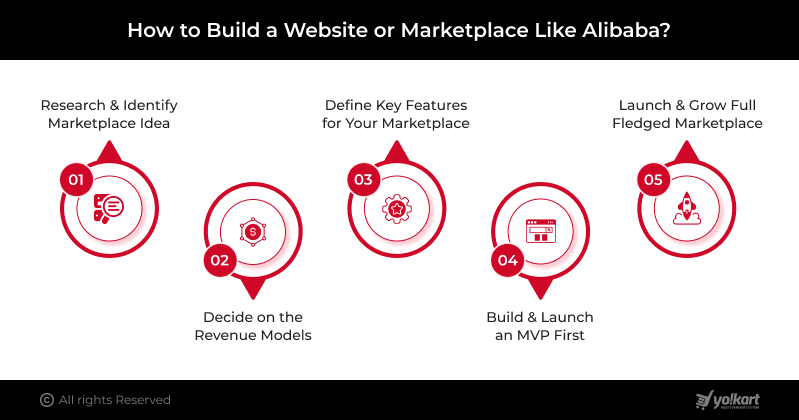
B2B eCommerce has shown substantial growth. According to the International Trade Administration, the global B2B eCommerce market size is expected to reach $36 trillion by 2026. The data indicates it’s the right time for entrepreneurs and startups to take advantage of this ever-growing eCommerce landscape.
If you are planning to build an eCommerce platform like Alibaba, it can be a game-changing decision. At the same time, you need to be careful to avoid potential threats to your business, investment and marketplace idea.
Below are a few time-tested steps suggested by industry experts to help you build a marketplace similar to Alibaba.
Step 1: Research and Identify Marketplace Idea
Alibaba is a dedicated B2B marketplace platform that connects manufacturers, suppliers, and wholesalers with global businesses that want to buy products in bulk at affordable rates. When planning to launch a marketplace like Alibaba, you need to discover a unique idea that can give your marketplace a competitive edge.
Hence, conduct thorough market research, analyze competitors, identify gaps, discover pain points, find an emerging market, understand targeted customers, and define a niche.
Moreover, conduct in-depth market research on Alibaba. It will also help you understand the areas and offerings where Alibaba itself is lacking and its customers are looking for an alternative that can meet their specific needs.
In addition, conducting market research will also give you an idea about the technology, budget and timeline required to build a B2B multi-vendor marketplace like Alibaba.
Step 2: Decide on the Revenue Models (Business Model)
If you want to build a marketplace like Alibaba, it clearly indicates a B2B eCommerce platform. However, when it comes to generating revenue for your eCommerce business, careful consideration is required. You can not simply decide on revenue generation streams that others are following.
Every business idea is unique. Hence, it requires a distinct approach to its monetization model considering the target audience, transaction type, users’ journey and more. Deduce with the revenue model that best suits your marketplace and its audience.
However, below are a few well-known revenue models marketplaces generate revenue from:
- Commission on Each Sale
- Subscriptions/Membership Fees
- Product Listing Fees
- PPC and Third-party Advertising
- Freemium Services
- Leads fees
You can choose any of the following or can implement a unique money-making idea that can help your business stand ahead and grow.
Step 3: Define Key Features for Your Marketplace
Operating a multi-vendor marketplace like Alibaba requires a comprehensive set of features and functionality to ensure seamless transactions on the platform. You need to define all the necessary features, functionality and services considering all the marketplace participants, their roles, operations and processes. The features listed below are critical when building a multi-vendor marketplace like Alibaba:
Features for Buyers:
- Easy Sign-up and Registration
- Search and Filter
- Add to Cart:
- Request for Quote (RFQ)
- Direct Communication
- Secure Payment:
- Trade Assurance:
- Product Comparison Tools:
- Order Tracking:
- Review and Ratings
Features for Suppliers
- Supplier Registration
- Digital Storefronts
- Product Listing
- Minimum Order Quantity
- Dynamic Pricing
- Direct Communication
- Order Management
- Advertisement
- Analytics and Reporting
Features for Admin
- User management
- Order Management
- Shipping Management
- Reporting and Analytics
- SEO and Marketing
- Content Management System
- Tax Management
- Ad Management Tool
- Dispute Handling/Customer Support
In addition to the above features, you can incorporate features and functionalities required specifically according to your business requirements.
Step 4: Build and Launch an MVP First
Building an MVP is a great way to validate your marketplace idea with a minimum investment. MVP (Minimum Viable Product) is the basic version of your full-fledged marketplace. It’s primarily designed to validate an idea, understand the user’s journey, and identify improvement areas.
It supports all the necessary features and functionality required to complete transactions for all user types. It significantly reduces the cost and time and helps entrepreneurs and business owners avoid potential threats to their ideas and investments.
An MVP is primarily intended to introduce its early adopters who explore and provide valuable feedback. Businesses implement feedback in order to improve the final product. MVPs are generally scalable platforms that can be expanded and grown as per the specific requirements. Ultimately, it contributes to saving time, money and resources alongside validating the marketplace idea.
Yo!Kart can be one of the best turnkey solutions to introduce your marketplace MVP, like Alibaba. It helps reduce the money and time required to launch a marketplace.
Step 5: Launch and Grow Full-Fledged Marketplace
In the final step, if you are satisfied with your marketplace MVP results, you can expand it into a full-fledged marketplace and launch. However, the job is not done yet. Operating a multi-vendor marketplace similar to Alibaba or any other requires a continuous effort.
From onboarding the maximum number of vendors to attracting more buyers and implementing new features to incorporating trends, your active participation is critical. Moreover, marketing and advertising are also one of those critical requirements that help you gain a competitive edge.
However, being a marketplace operator, you should always keep an eye on the users’ feedback, trends, and competitors to stay relevant, engaged and competitive.
Build a Multi-Vendor Marketplace Like Alibaba at an Affordable Cost
Yo!Kart is a white-label multi-vendor marketplace software. This readymade solution is primarily focused on providing entrepreneurs with a solution that enables them to build and launch a multi-vendor marketplace at an affordable price. It comes with all the necessary features and functionality required to operate an eCommerce platform.
If you are one of those entrepreneurs who is looking for a dedicated B2B marketplace software to build a platform like Alibaba, Yo!Kart B2B is right there for you. It’s a dedicated B2B multi-vendor marketplace software that supports B2B specific features and allows businesses of all sizes to trade seamlessly.
Moreover, choosing Yo!Kart as your marketplace software offers more than just a digital platform. The solution is fully customizable and scalable. Hence, you can tailor the platform to your specific needs and expand your eCommerce business without worrying about infrastructure and additional expenses related to expansion.
In addition, Yo!Kart’s source code ownership and self-hosted nature offer complete control over your marketplace and data, making it an ideal and better alternative to building a marketplace from scratch.
Launch a Fully Customizable and Scalable B2B Marketplace with Yo!Kart
Final Thought
In this informative guide on how to create a website like Alibaba, you have gone through every single detail about Alibaba. Starting from its history to understanding its business model, exploring Alibaba’s subsidiaries, features, and decoding its multiple and diversified revenue models.
In short, as an entrepreneur, you can collect all the necessary information about Alibaba that one should be aware of when building a B2B multi-vendor marketplace similar to it, including a step-by-step guide, costs and approaches to build.
I’m sure that if you are an entrepreneur planning to build a multi-vendor marketplace similar to Alibaba, you’ll consider YoKart, one of the most affordable and best readymade multi-vendor marketplace solutions.
FAQs
Q 1. Does Alibaba charge a commission on sales?
Ans. No, Alibaba doesn’t charge commission from sellers on sales. However, it charges payment processing fees on payments that take place through Alibaba.
Q 2. What are the revenue channels of Alibaba?
Ans. Alibaba generates revenue from other revenue streams like subscription charges, revenue from eCommerce subsidiaries, shipping services, payment and other financial services.
Q 3. Can I build an Alibaba-like B2B multi-vendor marketplace with Yo!Kart?
Ans. Yes, you can build an Alibaba-like B2B multi-vendor marketplace with Yo!Kart easily. Yo!Kart is a 100% white-label and readymade eCommerce solution that allows entrepreneurs and businesses to build their own eCommerce platform.
Q 4. Is Alibaba a B2B multi-vendor marketplace?
Ans. Yes, Alibaba is one of the top B2B multi-vendor marketplaces that enables businesses to trade in bulk online.
Q 5. Does Yo!Kart charge a recurring fee?
Ans. No, Yo!Kart doesn’t change any recurring fees or transactional charges. The solution is available at a one-time payment option. You can get a lifetime license to use Yo!Kart by paying once in a lifetime.
Q 6. How many buyers, sellers, listings and product categories are there on Alibaba?
Ans. Alibaba has over 40 million active B2B buyers, over 200K suppliers, 200 million+ listings and 5,900 product categories according to Alibaba.
Q 7. Is Alibaba a global B2B eCommerce platform?
Ans. Yes, Alibaba is a global B2B eCommerce platform. It operates across 200+ countries.
Q 8. How much does it cost to build a multi-vendor marketplace like Alibaba with Yo!Kart?
Ans. Building a multi-vendor marketplace similar to Alibaba starts at $1249 one-time. However, the final cost varies depending on your specific requirements.
Q 9. What are the subsidiaries of Alibaba Group?
Ans. AliExpress, 1688.com, Tmall, Juhuasuan, Lazada, and Taobao are popular eCommerce subsidiaries of Alibaba. Other than these, eCommerce platforms Alipay, Alimama, Alitrip, Aliyun and many other Alibaba subsidiaries are also contributing to its growth and expansion.
Q 10. Does Yo!Kart offer source code ownership?
Ans. Yes, Yo!Kart offers source code ownership, proving you have complete control over the platform.




